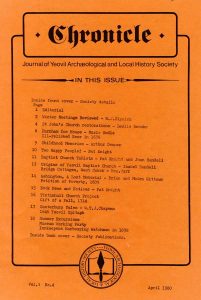1980-Apr-pg14_Ashington Church – A Lost Monument
This article came from Chronicle published April 1980. Page: 14
ASHINGTON CHURCH – A LOST MONUMENT
Author: Brian and Moira Gittos
St Vincent’s Church, Ashington, occupies a rather isolated situation 3¾ miles north of Yeovil, close to the course of the river Yeo. The church is one of a series near Yeovil with elaborate bell-cotes in lieu of a tower (of Brympton d’Evercy and Chilthorne Domer). A thorough restoration was carried out in 1878, it was probably then that an interesting early 14th century grave slab was lost from the church. Fortunately a drawing of the slab is preserved in the Gentleman’s Magazine for September 1820. This shows a mail-clad figure holding a stave, with a long shield, sword, and curious ‘kettle-shaped’ helmet. Traces of a marginal inscription in Lombardic characters are also shown. A rather better drawing of the figure alone can be found in the Archaeological Institute (Bristol) volume, 1851. In this drawing the figure is holding a spear and in both sketches the arms on the shield appear to be those of Raleigh (Gules, a bend fusilee argent).
Fryer, in his admirable work on Somerset Monumental Effigies, serialized in the Proceedings of Somerset Archaeological Society, describes the slab. He explains the link between the Raleigh family of Nettlecombe near Minehead and the Furneaux family who held the manor of Ashington at the time the monument would have been placed in the church, Sir Matthew Furneaux married Maud, daughter of Sir Warine de Raleigh of’ Nettlecombe. Sir Matthew died in 1318, and the slab probably commemorated a member of the Raleigh family who died in the early part of the 14th century.
It is interesting to note that there is preserved in Nettlecombe church a late 13th century effigy bearing the same arms as the Ashington slab and that, it appears to have been carved from a block of Ham Hill stone. It is one of the most distant figures to be carved from this material, but family ties with the Yeovil district may go some way to explaining the presence of a Hamstone effigy at so remote a church as Nettlecombe.
The Ashington slab is of particular interest because it shows two unusual features. Firstly there is the spear which also occurs on a broken incised slab at Chelvey near Clevedon and on the famous brass to Sir John d’Aubernon the elder at Cobham in surrey. Secondly, there is the almost comical headgear of the Ashington figure. It appears to represent an onion-shaped kettle-hat worn over a close-fitting bascinet. It is difficult to find parallels for this arrangement. However, a canopy figure (Almeric, Lord St Amand) on the Hastings brass at Elsing in Norfolk, dated 1347, shows a superficial similarity. Opinions differ about the interpretation of this illustration (see Druitt’s ‘Manual of Costume as Illustrated by Monumental Brasses’, p.154, plate IV).
It is regrettable that,the Victorian ‘restorers’ did not see fit to preserve this rare monument. There are only five incised figure slabs prior to 1400 remaining in the whole of Somerset, and this particular slab illustrated a feature of great interest.
